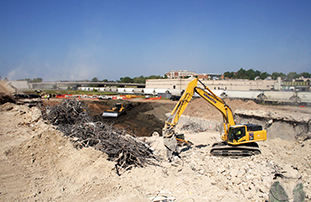We are often asked what to do with excess contaminated fill soils or “dirty dirt” from construction or redevelopment projects. Off-site reuse of excess contaminated fill is a common practice for many contractors throughout Minnesota. Thus creating a “Dirty World!”
Sometimes, without knowing it, excavation contractors move and reuse contaminated fill from one project to another, spreading it around. Yes, it’s a “Dirty World!”
In the Twin Cities, for example, a large number of urban fill soils have some level of contamination from historical activities conducted on the site or due to import from some other unknown source. Beware – this contaminated fill could be above Minnesota Pollution Control Agency (MPCA) concern levels. You can’t just take this “dirty dirt” anywhere. It should be managed or disposed of in accordance with applicable regulations.
The MPCA has recently published new policy and guidance documents regarding best management practices for off-site reuse of urban fill soils with contamination.
Basically, there are two types of guidance for reuse: In Part 1 of this series, we discussed MPCA guidance for “unregulated fill.” Unregulated fill contains contaminants at concentration levels that are not of concern to the MPCA. In Part 2, we discuss MPCA guidance for “regulated fill.” Regulated fill contains contaminants at concentration levels that are of concern to the MPCA.
What is Regulated Fill?
Regulated Fill is soil that contains contaminants within the following levels:
- May contain a small amount of inert debris, such as fragments of brick, concrete, glass, or metal.
- Organic vapors greater than 10 ppm and less than 200 ppm, as measured by a photoionization detector (PID). However, there are restrictions as to where soil with this type of contaminant can be placed at the receiving site.
- Petroleum constituents greater than 100 mg/kg diesel range organics (DRO) and/or gasoline range organics (GRO) as analyzed in a laboratory.
- Metals or semi-volatile organic compounds (SVOCs) between the MPCA’s residential and industrial Soil Reference Values (SRVs).
- Volatile organic compounds (VOCs) (found in gasoline, dry cleaning solvents, and degreasers) between the MPCA’s default Tier 1 Soil Leaching Values (SLVs) and the site-specific Tier 2 SLVs for the importing site. A SLV is the level the VOC will leach and contaminate groundwater. If clay is present in the soils, it will slow leaching to groundwater.
MPCA’s SRVs and SLVs can be found on the MPCA website.
Exclusions to MPCA’s Regulated Fill Guidance
Contaminated fill that does not meet the requirements for unregulated or regulated fill must be disposed of at a landfill.
- Soil contaminated with agricultural chemicals
- Soil with asbestos-containing material
- Soil with significant amounts of demolition debris, industrial waste, or other solid waste
- Soil contaminated with hazardous waste levels or above the contaminant levels listed above
- Soil with chemical odors that are a nuisance to the public at the receiving site
- Non-soil materials (such as crushed concrete, bricks, etc.) that are proposed to be beneficially used as fill
- Dredge materials
Sampling Requirements
Before any regulated fill is reused, the MPCA requires a sampling plan to determine its level of contamination. It’s best to submit your plan as soon as possible; it could take the MPCA up to 30 days to review and approve it. Soil sample numbers and costs for regulated fill would be similar to unregulated fill (see Part 1 of this series).
Regulated Fill Use Requirements for Both Export and Import Sites
Before the regulated fill is moved from one site to another, the MPCA requires each site to comply with several requirements.
BROWNFIELDS AND ENVIRONMENTAL SITE ASSESSMENT REQUIREMENTS
Both sites must be enrolled in the MPCA Brownfields Program. Phase I and Phase II environmental site assessments must be conducted on each site in accordance with MPCA standards.
APPLICATION AND PLAN REQUIREMENTS
It’s also necessary to compile a management and reuse plan. If cleanup actions are needed at the site, this plan is usually in the form of a Response Action Plan. If cleanup actions are not needed, a Soil Management Plan is appropriate. The management and reuse plan must be approved by the MPCA for both sites.
A Regulated Fill Application, including the plans and laboratory sampling results, must also be submitted to the MPCA for review and approval. The property owners of both sites are required to sign the application. Also, local unit(s) of government (could include county auditors, city clerks, town clerks, or other person designated to receive notifications) must have an opportunity to review it. The local unit of government must sign a Local Government Notification Form to confirm receipt of the information.
The origin, final disposition, and placement of the regulated fill must be described in an Implementation Report and must be submitted to the MPCA for review and approval.
GUIDELINES FOR IMPORTING REGULATED FILL
It’s important to note that regulated fill can ONLY be used at restricted commercial or industrial sites that have the same types of existing contamination. For example, you can’t take lead contaminated soils to a site that isn’t already contaminated with lead. Additionally, the regulated fill must be placed in areas that do not affect human health and the environment. This means it’s better to put contaminants like petroleum or VOC contaminated soils under paved parking lots instead of under buildings, which could allow vapors to escape.
In some cases, an institutional control may be required for the import site, which would become part of the property deed. The institutional control could range from simply noting where contaminated soils exist to restricting how the site can be used in the future.
Final placement of regulated fill at the importing site must be in accordance with the timeframe described in the regulated fill application. It’s worth noting that you can’t stockpile regulated fill for long periods of time on the import site—and you can’t stockpile the regulated fill somewhere else.
MPCA Approvals and Assurances
The MPCA will not take any action against persons who move regulated fill in accordance with their policies. If you follow their guidelines and gain their approvals before you move and place the soils, you will receive an assurance letter from the MPCA.
Part One of It’s A Dirty World can be found here: /resources/articles/2014/12/its-dirty-world-part-one/
More information about Brownfield Redevelopment projects such as the St. Paul Port Authority – Beacon Bluff Redevelopment can be found here: /market-focus/commercial/st-paul-port-authority-beacon-bluff/
Kate Kleiter is a hydrogeologist and former manager of AET’s St. Paul Environmental Department. If you have any questions about AET’s Environmental Services please contact Gail Cederberg, PhD by email at gcederberg@amengtest.com.


